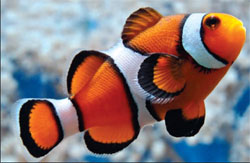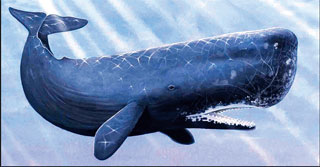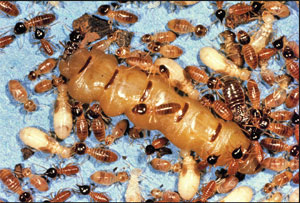|

Sea creatures
1.Which is the tallest fish?
2.What sea creatures plant a garden on their backs?
3.Which is the deepest diver?

4.Which fish is the fastest swimmer?
5.How do herring avoid being eaten by prey?
6.What is slimy and hides in anemones?
7.Which creature throws ink at its enemies?
8.Which seal has a beard?
9.What sleeps in a duvet of seaweed?
10.What hunts by sonar?
Answers
Sea creatures
1. Ocean sunfish. They can measure over 4m (14 feet) high including
their long back and belly fins. These large fish can weigh over two
tonnes.
2. Spider crabs make their own disguises from materials they find in
the sea around them. They clip living sponges or fronds of seaweed with
their strong pincers and plant them on their back. When seaweed dies,
they replace it with a fresh piece.
3. Sperm whales. Like all whales they breathe at the surface but swim
down to depths of 500m (1,600 feet) to hunt deep-sea creatures such as
giant squid.
 4.
Sailfish are large hunting fish that live in the open ocean. With their
long, streamlined snouts, torpedo-shaped bodies and powerful tails they
can speed along at up to 109 kph (67 mph). 4.
Sailfish are large hunting fish that live in the open ocean. With their
long, streamlined snouts, torpedo-shaped bodies and powerful tails they
can speed along at up to 109 kph (67 mph).
5. Herring and mackerel swim in groups known as shoals - because
there is safety in numbers.
It is difficult for predators to single out a likely target from
among a shifting ,shimmering mass of fish.
6. Clown fish. They have bodies which are covered in a thick layer of
slimy mucus and so they can hide among the stinging tentacles of sea
anemones without coming to any harm.
7. Cuttlefish. As they are relatives of squid and octopus, cuttlefish
too can produce a cloud of ink to confuse their enemies. The cuttlefish
jets away under cover of the ink ‘smokescreen.’
8. The bearded seal. It has a magnificent set of long whisker - like
hairs on its nose. It uses its sensible beard to feel for shell fish
lurking on the sea and fish hiding in the cool water.
9. The sea otter. It makes its home among the kelp and weed beds of
the eastern Pacific. While resting the otter wraps seaweed fronds around
its body so it does not drift away with the ocean currents.
10. Dolphins hunt with the aid of their own built in sonar system.
World of insects

1.What is cuckoo-spit?
2.Which bug spends years underground?
3.Which are the biggest spiders?
4.How many eggs does a queen termite lay?
5.What is the name of the longest stick insect?
6.Why were dung beetles sacred?
7.How many earthworms are there in a bucket of soil?
8.Which is the world's fastest snail?
9.How does a jewel wasp gets its name?
10.How do scorpions look after their young?
Answers
World of insects
1.Cuckoo-spit does not come from cuckoo birds. The ‘frothy’ spit is
made by a frog hopper larva. It blows air into a liquid that it releases
from the rear end of its body. The froth the lava produces protects it
from predators and also keeps it moist. Adult frog hopper bugs are good
at hopping and that is what gives them their name.
2.The periodical cicada of America. It has a lifespan of 17 years and
most of its life is spent underground. It digs its way through with its
big front legs and feeds on the sap of plant roots.
3.The bird eating spiders of South America. They are the heaviest and
widest species with weights up to 80g (3 oz) and leg spans up to 26 cm
(10 in). Although they are called bird eating spiders, very few of them
actually eat birds. The bigger spiders eat small frogs, lizards and
snakes.
4.A queen termite's only job is to lay eggs. In some termite species,
a queen may lay up to 30,000 eggs a day.
5.The largest stick insect is the saw-footed stick insect of
South-east Asia. It grows up to 33 cm (13 in) long – as long as a pet
rabbit.

6.The scarab dung beetles were sacred in ancient Egypt because the
Egyptians thought they were linked to the gods they worshipped. The
beetles gather a ball of dung that they roll away to a hole as food for
their young. To the ancient Egyptians, this ball symbolised the globe of
the Sun being pushed across the sky each day by the Sun god.
7.In fertile soil there may be as many as 700 earthworms under each
square metre. An average bucket of soil may contain up to 200
earthworms.
8.Most snails are so slow-moving that nobody has taken an interest to
even measure their speed. However, according to available records, the
fastest snail is the common garden snail, Helix aspersa which could move
at 0.05 kmph (0.03 mph).
9.The jewel wasp of Western America is named for the bright metallic
colours on its body case which makes it look like a gleaming jewel.
10.Most mini beasts take little care of the young, but female
scorpions are protective mothers.
The young scorpions usually ride round on their mother's back,
staying safe beneath her deadly sting. They drop off and fend for
themselves after three weeks. |



